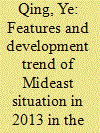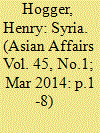| Srl | Item |
| 1 |
ID:
128329


|
|
|
|
|
| Publication |
2013.
|
| Summary/Abstract |
The situation in Middle East is full of twists and turns in 2013, demonstrating a transitional character of the transformation of regional architecture. It has projected a certain extent of inheritance on the one hand and some tendencies for future development on the other. The adjustment of Mideast regional architecture will be shaped in the process of continuous rivalry between the new and old forces, the mutual adaptation of new and old modes and constant interaction between big powers and regional countries.
|
|
|
|
|
|
|
|
|
|
|
|
|
|
|
|
| 2 |
ID:
128024


|
|
|
|
|
| Publication |
2014.
|
| Summary/Abstract |
From independence, Syria evolved somewhat differently from other Arab states. When Hafez al-Assad took over, internally he favoured a very Soviet-style centralisation of power and in the eyes of the West his foreign policy made Syria a "pariah" state. When his son Bashar succeeded him, there were hints of an open-ness to new political and economic thinking. European powers started to thicken up their relationship. The US/UK invasion of Iraq put an end to that. The Old Guard regained the ground they had lost. At least on the surface, the economic situation seemed manageable, though agricultural livelihoods were deteriorating sharply. Enter the Arab Spring. The regime's response was brutal and widely condemned, but in an international context very different from that of other threatened Arab regimes. Syria is a major Russian client and an ally of Iran. Nor were there easy choices for the West. The initially-moderate opposition splintered, with Islamist forces increasingly prominent. If there is a slender hope for the future it lies in building on the recent US/Russian diplomatic cooperation over the dismantling of the Syrian chemical weapons arsenal. The improved atmosphere in the talks over the Iran nuclear issue could also be a possible ray of sunlight. But the present situation is grim: casualties are mounting and the immense refugee problem needs more attention from the West.
|
|
|
|
|
|
|
|
|
|
|
|
|
|
|
|
| 3 |
ID:
114964


|
|
|
|
|
| Publication |
2012.
|
| Summary/Abstract |
As Iran steadily develops the capacity to construct nuclear weapons, Washington and Ankara are increasingly on the same page, although key differences persist. Since the start of the Arab uprisings, Turkey and Iran have found themselves supporting different political factions in Syria and Bahrain. Turkey has retreated from its self-assigned role as Iran's diplomatic defender following a period of unusual warmth between Ankara and Tehran in 2009 and 2010. The current regional dynamics have pushed Ankara's immediate foreign-policy interests back into broad alignment with those of its traditional Western allies, notably Washington.
|
|
|
|
|
|
|
|
|
|
|
|
|
|
|
|